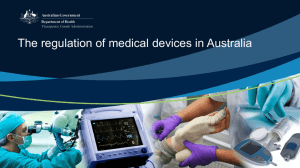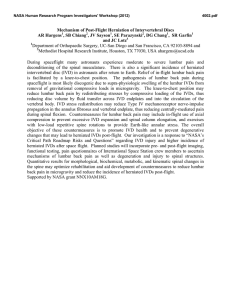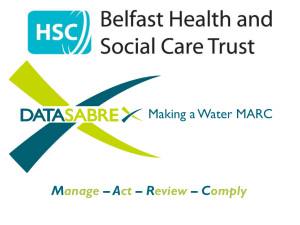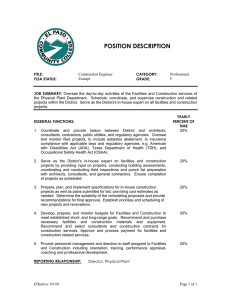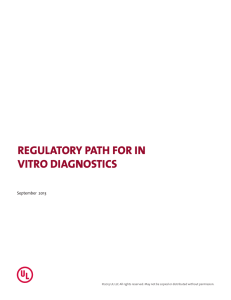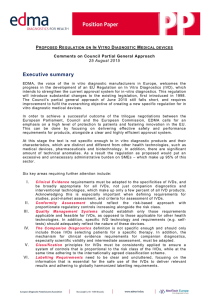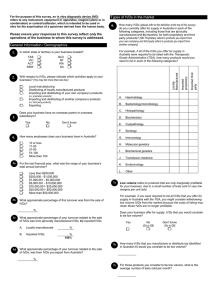Labs Questionnaire V13.doc
advertisement
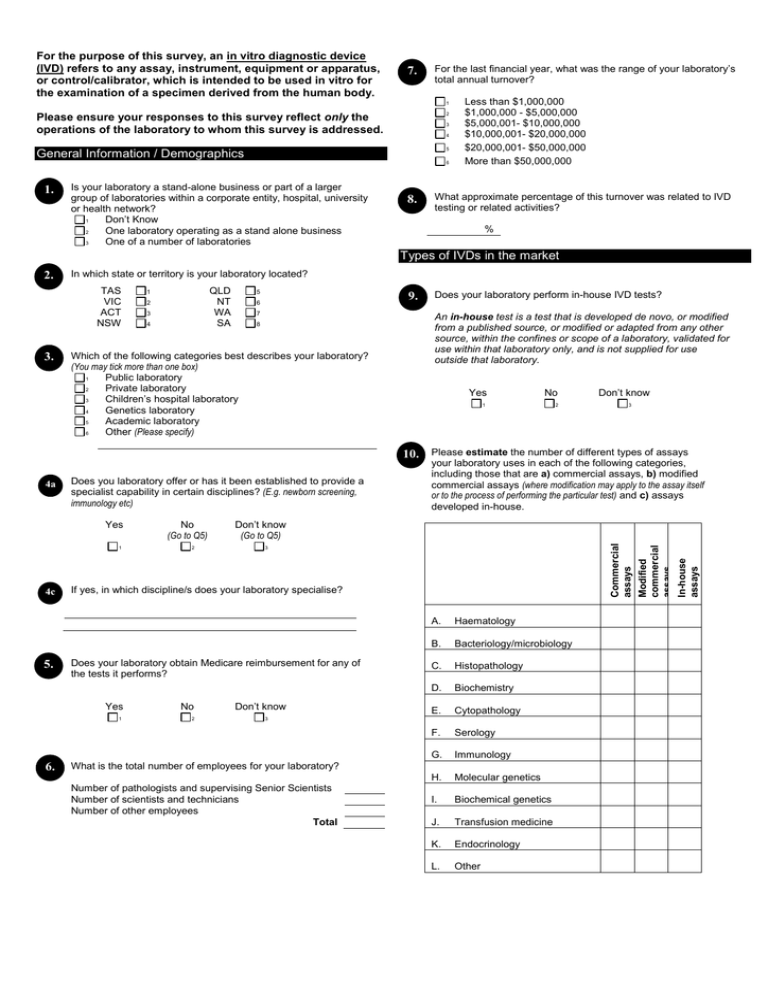
For the purpose of this survey, an in vitro diagnostic device (IVD) refers to any assay, instrument, equipment or apparatus, or control/calibrator, which is intended to be used in vitro for the examination of a specimen derived from the human body. 7. For the last financial year, what was the range of your laboratory’s total annual turnover? 1 Please ensure your responses to this survey reflect only the operations of the laboratory to whom this survey is addressed. 2 General Information / Demographics 5 3 4 6 1. Is your laboratory a stand-alone business or part of a larger group of laboratories within a corporate entity, hospital, university or health network? 1 Don’t Know 2 One laboratory operating as a stand alone business 3 One of a number of laboratories 8. Less than $1,000,000 $1,000,000 - $5,000,000 $5,000,001- $10,000,000 $10,000,001- $20,000,000 $20,000,001- $50,000,000 More than $50,000,000 What approximate percentage of this turnover was related to IVD testing or related activities? % Types of IVDs in the market 2. In which state or territory is your laboratory located? TAS VIC ACT NSW 3. QLD NT WA SA 1 2 3 4 5 9. 6 7 8 Which of the following categories best describes your laboratory? (You may tick more than one box) 1 Public laboratory 2 Private laboratory 3 Children’s hospital laboratory 4 Genetics laboratory 5 Academic laboratory 6 Other (Please specify) Does your laboratory perform in-house IVD tests? An in-house test is a test that is developed de novo, or modified from a published source, or modified or adapted from any other source, within the confines or scope of a laboratory, validated for use within that laboratory only, and is not supplied for use outside that laboratory. Yes No 1 2 Don’t know 3 10. Please estimate the number of different types of assays Does you laboratory offer or has it been established to provide a specialist capability in certain disciplines? (E.g. newborn screening, immunology etc) Yes 1 4c 5. 2 Don’t know (Go to Q5) 3 If yes, in which discipline/s does your laboratory specialise? Does your laboratory obtain Medicare reimbursement for any of the tests it performs? Yes 1 6. No (Go to Q5) Commercial assays Modified commercial assays In-house assays 4a your laboratory uses in each of the following categories, including those that are a) commercial assays, b) modified commercial assays (where modification may apply to the assay itself or to the process of performing the particular test) and c) assays developed in-house. No 2 Don’t know A. Haematology B. Bacteriology/microbiology C. Histopathology D. Biochemistry E. Cytopathology F. Serology G. Immunology H. Molecular genetics I. Biochemical genetics J. Transfusion medicine K. Endocrinology L. Other 3 What is the total number of employees for your laboratory? Number of pathologists and supervising Senior Scientists Number of scientists and technicians Number of other employees Total Impact of regulatory proposal In the proposed new regulatory framework, IVDs are to be classified using a set of rules. The TGA has proposed that the responsibility for IVD risk classification will lie with manufacturers, who will classify their products using a set of rules. The TGA will then confirm or revise the risk class upon receipt of the application. The TGA has proposed that there be four risk classes (see below) and that a given product’s risk classification will determine the requirements to be met prior to its supply on the Australian market, with requirements increasing as risk level increases. Class I represents the lowest risk class, while Class IV represents the highest risk class. 11. Total No 1 15a Don’t know 2 3 Is your laboratory accredited with NATA/RCPA? (The joint accreditation scheme provided by the National Association of Testing Authorities Australia in conjunction with the Royal College of Pathologists of Australasia) Yes No 1 Don’t know 2 3 % 15b Does your laboratory hold any other quality accreditation? % Yes No (Go to Q16a) 1 Don’t know (Go to Q16a) 2 3 % % 15c If yes, who is your laboratory accredited with? 16a Go to question 18 if you do not develop in-house tests 100 % Does your laboratory perform small volume tests? A small volume test is one that is performed infrequently (20 times per month or less), because either the test is used to detect a disease that occurs with very low incidence, or the technology used in the assay is not widely available. Yes Does your laboratory keep records of the test development and validation data for any of the IVDs it develops in-house? Yes Don’t know No 1 13. Is this position full-time? (i.e. Does this person devote more than 75% of a normal working week to quality management)? Yes Looking at the total number of IVDs that your laboratory uses (as identified in Question 10), please estimate what approximate percentage of these IVDs fall into each of the following proposed risk classes: Class IV - High public health risk E.g. IVDs used to screen blood or tissue donations etc. for the presence of serious disease causing or life-threatening pathogens. Class III – High personal risk / Moderate public health risk E.g. IVDs used in the diagnosis of rubella infection in pregnancy, IVDs for the detection of some cancer markers. Class II – Low public health risk / Moderate personal risk E.g. IVDs for pregnancy testing, thyroid stimulating hormone, etc. Class I – No public health risk / Low personal risk E.g. Media used to identify or infer the identity of a micro-organism, IVD instrumentation. 12. 14b 2 3 No (Go to Q17) 2 1 What approximate percentage of your in-house IVDs are produced because there are a) no available commercial alternatives, b) the in-house IVD is more cost effective, c) the in-house IVD is technically superior, or d) for some other reason? 16b Don’t know (Go to Q17) 3 If yes, what approximate percentage of the in-house tests your laboratory develops, do you have test development and validation data records for? % A. No commercial IVDs available % B. In-house IVDs are more cost effective % C. In-house IVDs are technically superior % D. Other (please specify the reason/s below) % 17. 14a Does your laboratory have a quality manager? Yes 1 No (Go to Q15a) 2 Don’t know (Go to Q15a) 3 What approximate percentage of the in-house tests that your laboratory develops could be characterised as a) a published method, b) a modified published method, c) a de novo method, or d) modification of a commercial IVD? A. Published method % B. Modified published method % C. De novo method % D. Modification of a commercial IVD % In its discussion paper (see front cover), the TGA has proposed a number of options for increasing its level of regulatory oversight of in-house IVD tests. 18a What do you think will be the impact on your laboratory, of increased regulation of in-house tests by the TGA? 18b In what ways do you think increased regulatory oversight of in-house IVD tests by the TGA could deliver benefits to your laboratory and the wider industry? 19. Approximately how long did this questionnaire take you to complete? Hours Minutes Thank-you for assisting us with this survey. PLEASE RETURN YOUR COMPLETED SURVEY FORM TO PIAZZA CONSULTING IN THE REPLY PAID ENVELOPE PROVIDED BY DATE. PO Box 575 Woden ACT 2606 Ph: (02) 6282 4963 Fax: (02) 6282 4953
